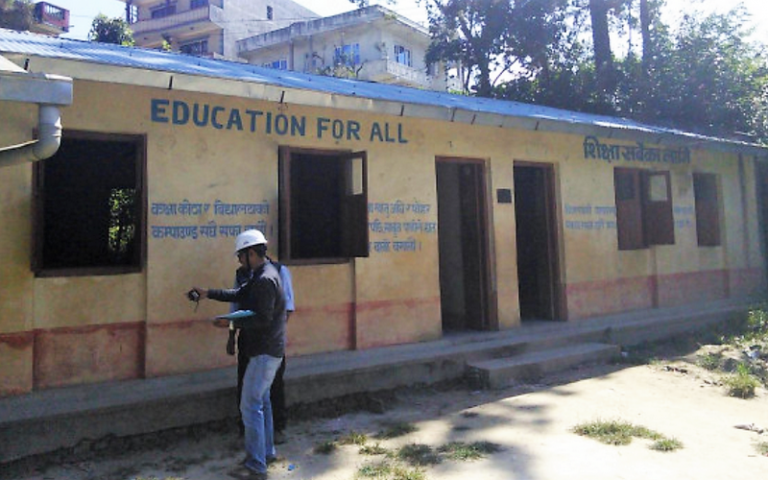Infrastructure vulnerability assessment tools help protect against natural hazards
UCL research predicts the vulnerability of buildings and infrastructure to natural hazards, leading to a series of risk models that are used worldwide to predict the impacts of natural hazards.

12 April 2022
In many parts of the world, natural hazards such as earthquakes present a real threat to people’s safety. The risk to buildings and people from a natural hazard is a function of three components: hazard, exposure, and vulnerability. The vulnerability links the hazard and exposure components, and is a measure of the safety of the built environment as it stands and is a critical factor when considering risk reduction policies.
Effectively predicting natural hazard vulnerability is complex. Professors Tiziana Rossetto and Dina D’Ayala at UCL's Department of Civil, Environmental and Geomatic Engineering successfully developed new guidelines, statistical models and open access computational code to assist vulnerability predictions.
The developed approaches incorporate the variability of the ‘as built’ nature of structures and also non-engineered structures that make up most of the built environment in areas where earthquakes (and other natural hazards) are common.
Developing models to protect people and buildings at risk of natural hazards
Research commissioned by the Global Earthquake Model Foundation (GEM), in close collaboration with international partners, included gathering extensive evidence, numerical modelling, statistical testing and sensitivity analyses.
The team developed guidelines for empirical and analytical vulnerability modelling that allow experts with a range of skills to develop new vulnerability models for particular settings.
The models are being used by NGOs, finance industries and governments worldwide to inform disaster risk assessments and mitigation plans to protect people and buildings at risk of natural hazards.
Worldwide application of the guidelines across several industries
The guidelines have been applied extensively and were used by GEM to develop the first detailed Seismic Risk Map of the world in December 2018. They include several tools for predicting vulnerability and are state-of-the-art, globally recognised and freely available.
One of the tools – FaMIVE - focuses on the out-of-plane failure of masonry structures and has been endorsed by the Catholic Church in the Philippines to perform vulnerability assessments of their historical churches, which are often used as shelters during seismic events.
The methods and tools are being used by insurance companies to calibrate the pricing of insurance products. The World Bank has used them to calibrate their Global Rapid post-disaster damage estimate (GRADE) to help national governments rapidly assess damage and develop strategies to support post disaster recovery and reconstruction.
In 2016 the Global Programme for Safer Schools (GPSS) invited Professor D’Ayala to design a framework for the Global Library of School Infrastructure (GLOSI). The GLOSI, implemented in collaboration with UNiAndes, Bogotá, Colombia, is a global repository of evidence-based knowledge on the performance of school building types affected by natural hazard events. Through third party applications, the GLOSI is currently used by Ministries of Education in more than 20 countries worldwide.
Professor D’Ayala said: "The UCL seismic analytical vulnerability and risk analysis tools are core to the Global Programme for Safer Schools’ GLOSI tool, used to assess the need for retrofitting over 57,000 schools in developing countries and to develop and implement conservation management plans for historical churches in the Philippines."
Research synopsis
Infrastructure vulnerability assessment tools help protect people and places against natural hazards
UCL’s research to predict the vulnerability of buildings and infrastructure to natural hazards has led to a series of risk models and products that are used worldwide to predict the impacts of natural hazard events, to inform insurance pay-outs and strengthen buildings, such as schools and churches.
Project team: Professor Tiziana Rossetto, Professor Dina D'Ayala, Professor Carmine Galasso, Dr Ioanna Ioannou, Dr Abdelghani Meslem, Dr Viviana Novelli, Enrica Verrucci, Dr Arash Nassirpour, Dr Rohit Adhikari, Harriette Stone, Dr Pierre Gehl
Links
- Professor Tiziana Rossetto's academic profile
- Professor Dina D'Ayala academic profile
- UCL Department of Civil, Environmental & Geomatic Engineering
- UCL Faculty of Engineering Sciences
- UCL Faculty of Engineering Sciences REF 21
Image
- Image credit: UCL
 Close
Close

